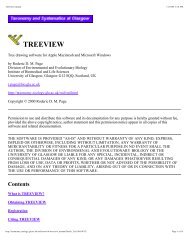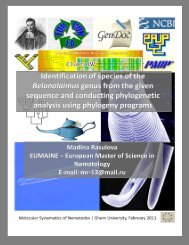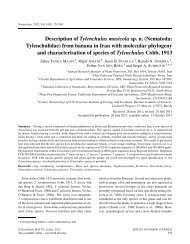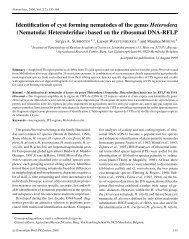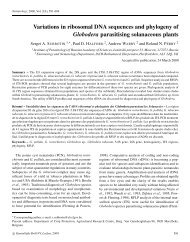Identification of the beet cyst nematode Heterodera schachtii by PCR
Identification of the beet cyst nematode Heterodera schachtii by PCR
Identification of the beet cyst nematode Heterodera schachtii by PCR
You also want an ePaper? Increase the reach of your titles
YUMPU automatically turns print PDFs into web optimized ePapers that Google loves.
500<br />
Table 2. Primer sequences<br />
Primer Sequence 5 ′ –3 ′ Reference<br />
TW81 GTTTCCGTAGGTGAACCTGC Joyce et al. (1994)<br />
AB28 ATATGCTTAAGTTCAGCGGGT Joyce et al. (1994)<br />
5.8SM2 CTTATCGGTGGATCACTCGG Zheng et al. (2000)<br />
5.8SM5 GGCGCAATGTGCATTCGA Zheng et al. (2000)<br />
SHF6 GTTCTTACGTTACTTCCA Present study<br />
rDNA2 TTTCACTCGCCGTTACTAAGG Vrain et al. (1992)<br />
D2A ACAAGTACCGTGAGGGAAAGTTG De Ley et al. (1999)<br />
D3B TCGGAAGGAACCAGCTACTA De Ley et al. (1999)<br />
Figure 1. Position <strong>of</strong> primers used in <strong>PCR</strong> and alignment <strong>of</strong> a fragment <strong>of</strong> rDNA sequences <strong>of</strong> <strong>Heterodera</strong> <strong>schachtii</strong> and closely related<br />
species. The bold and underlined characters indicate <strong>the</strong> sequence <strong>of</strong> <strong>the</strong> specific primer SHF6.<br />
1.5 min at 55 ◦ C and 2 min at 72 ◦ C; followed <strong>by</strong> a<br />
final elongation step <strong>of</strong> 10 min at 72 ◦ C. After DNA<br />
amplification, 5 µl product was run on a 1% agarose gel<br />
(100 V, 45 min). The remainder was stored at −20 ◦ C.<br />
For twenty-five H. <strong>schachtii</strong> populations and two<br />
H. betae populations (Table 1), 5 µl <strong>PCR</strong> product<br />
was digested with MvaI, RsaI and PvuII.<br />
Additionally, for one population <strong>of</strong> H. <strong>schachtii</strong>,<br />
H. betae, H. trifolii and H. medicaginis (Table 1),<br />
<strong>the</strong> <strong>PCR</strong> product was also digested with each<br />
<strong>of</strong> following enzymes: AluI, AvaI, CfoI (Promega,<br />
Leiden, The Ne<strong>the</strong>rlands) BseNI, Eco72I, MvaI, RsaI<br />
(MBI Fermentas, St. Leon-Rot, Germany) and ScrFI<br />
(Eurogenetec, Seraing, Belgium) according to <strong>the</strong> manufacturer’s<br />
instructions. The digested DNA was loaded<br />
on a 1.5% agarose gel, separated <strong>by</strong> electrophoresis<br />
(100 V, 2.5 h), stained with ethidium bromide, visualised<br />
and photographed under UV-light. Procedures<br />
for obtaining <strong>PCR</strong>-amplified products and endonuclease<br />
digestion <strong>of</strong> <strong>the</strong>se products were repeated at least<br />
twice to verify <strong>the</strong> results.<br />
Cloning and sequencing<br />
<strong>PCR</strong> products <strong>of</strong> three populations <strong>of</strong> H. <strong>schachtii</strong><br />
(Ohain, Belgium; Münster, Germany; Ouled Mbarek,<br />
Morocco) and <strong>of</strong> one population <strong>of</strong> H. betae (Berkane,<br />
Morocco) were excised from 1% TBE-buffered<br />
agarose gels using <strong>the</strong> QIAquick Gel Extraction Kit<br />
(Qiagen), cloned into <strong>the</strong> pGEM-T vector and transformed<br />
into JM109 High Efficiency Competent Cells<br />
(Promega, Leiden, <strong>the</strong> Ne<strong>the</strong>rlands). Several clones <strong>of</strong><br />
each species were isolated using blue/white selection<br />
and submitted to <strong>PCR</strong> with vector primers. The <strong>PCR</strong><br />
product from each clone was digested <strong>by</strong> MvaI, RsaI<br />
or PvuII to identify <strong>the</strong> ITS haplotype. From each population<br />
three clones were selected and sequenced in<br />
both directions using two vector primers, one internal<br />
forward primer 5.8SM2 and one internal reverse<br />
primer 5.8SM5 or TW81 (Table 2) with <strong>the</strong> BigDye<br />
Terminator Cycle Sequencing Ready Reaction Kit<br />
(PE Biosystems Benelux, The Ne<strong>the</strong>rlands) according<br />
to <strong>the</strong> manufacturer’s instructions. The program



